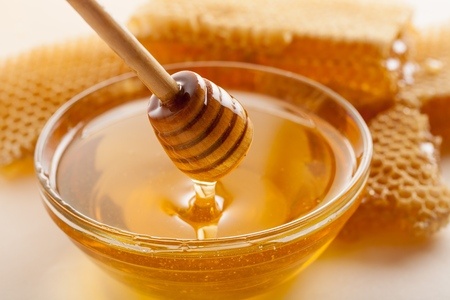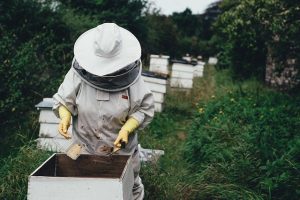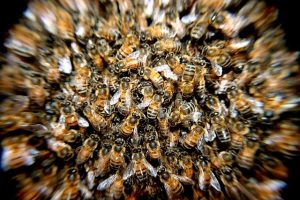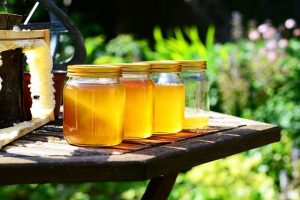
Honey has been used by people since ancient times ever since they discovered it has a sweet taste. It’s both food and traditional folk medicine and has been used throughout ancient lore around the world. This natural food continues to offer us great health benefits. It not only provides us with a sustainable source of metabolic energy but also functions as a food preservative. Every country in the world produces honey.
Honey is also full of different compounds even though we think of it as 100 per cent natural sugar. It is in fact a very complex mixture of about 200 compounds. In many parts of the world, it is the only concentrated form of sugar available but with some very interesting other componentry which deserve greater attention.
Honey is produced by bees (Apis mellifera) – a simple fact. Indeed we cannot think about this sweet sticky viscous liquid without the image of this ungainly insect buzzing into view. Bees make honey as a sweet and thick liquid to sustain them through the times when there are no flowers to pollinate. It is produced as a result of their incessant collection of nectar where it is turned into honey in the hive.

Production Of Honey
Only worker bees collect nectar which is rich in sugars from flowers bearing pollen. They also collect secretions and honeydew from a variety of plants. In the beehive, the bee digests the nectar with secreted enzymes from special glands as a fly might a piece of meat, converting the nectar into this sugar like substance which is effectively ‘regurgitated’ (Balasubramanyan, 2011). Inside the colony, forager bees with full honey sacks transfer nectar into honeycombs and then flutter their wings to speed up the decrease of moisture until it is lower than 18% before the cells are sealed by workers. The end product becomes honey which is the bee’s energy store and the honeycomb is the bee’s store cupboard.
The type of flower visited determines the aroma, flavour and colour.
Commercial Processing Of Honey
The conventional method for processing honey is the following:-
- Raw honey is quality checked
- Preheating
- Straining to remove suspended particles
- Filtration to remove fine particles
- Heating to reduce moisture and yeast count
- Cooling
- Bottling
A key feature of honey processing is to use heat to make sure all the dextrose crystals in honey are dissolved fully and yeasts are destroyed.
Straining
Straining removes suspended solids, especially large wax particles. This is performed either manually or by mechanical means. The method and the equipment used for straining depend on the size of the operation. In small-scale operations, straining is done using cloth or nylon bags, which are frequently cleaned to remove the suspended particles. In large-scale operations, the straining operation is combined with the pre-heating (up to 40°C) operation in a jacketed tank fitted with a stirrer.
The honey is usually filtered by fine sieving and pressure filtration.
Most sterilisation methods use tube-in-tube pasteurisers which not only kills the yeasts but prevent regranulation on cooling. The cooling process is perhaps the most critical part of producing honey to avoid undue browning (Townsend, 1975).
Grading of Honey
Honey is graded on its color and optical density by U.S. Dept. of Agriculture standards, using a scale called the Pfund scale. The Pfund scale ranges from 0 for “water white” honey to 114 for “dark amber” honey. Grade A honey is very clear and has a high flavour and aroma performance. High-quality honey should flow from a knife with a straight stream at 20°C.
The typical pH of honey is 3.9. The melting point of crystallized honey is between 40°C and 50°C. The moisture content ranges from 13% to 20%.
Nutrition
Honey is rich in nutrients and active ingredients! A tablespoon is about 21 grams weight and has an energy content of 64 calories of which 17 grams is mainly carbohydrate (80% to 85%). The carbohydrates are principally fructose and glucose. There is a tiny amount of maltose and sucrose.
A few proteins are found (0.1% to 0.4%) and some ash (0.2%).
Honey contains extremely small amounts of amino acids one of which, proline predominates. The rest are colour pigments, pollen, some enzymes (protein), organic acids, pollen and wax. It contains no fat or fibre. Trace amounts of vitamins are present – generally under 1 per cent of the RDA and is not noted for any particular mineral either although it is mostly potassium (Almeida-Muradian et al., 2013).
The aliphatic acids in honey contribute greatly to the flavor.
What is most interesting is the presence of antioxidants and other bioactive compounds. It is these which give honey some of its more unusual and beneficial properties. Dark honey appears to be richer in these type of compounds and is generally to be preferred to the lighter types.

Components
Honey contains at least 200 components and is basically a supersaturated solution of sugars, of which fructose (38%) and glucose (31%) are the most abundant. The moisture content is about 17.7% w/w, its total acidity 0.08% and the ash content is 0.18% w/w (Gheldof et al., 2002).
Phenols, phenolic acids, enzymes, flavonoids such as chrysin, fisetin, pinocembrin etc. and various organic acids like gluconic acid have been isolated (Viuda-Martos et al., 2008; Badjah Hadj Ahmed et al., 2014; 2016).
The contents of phenolic acids, flavonoids and phenolics in 12 Yemeni honey samples was in a range of 363–2658, 261–1646, and 224–1355 μg/100 g respectively (Badjah Hadj Ahmed et al., 2014). The main phenolic acid, flavonoid and phenolic compounds in these samples were 4-hydroxybenzoic acid (1410 μg/100 g), chrysin (850 μg/100 g), and cinnamic acid (1336 μg/100 g), respectively.
Antioxidant Properties
Honey is a great source of natural antioxidants. The range of antioxidants is quite important and the combination may be one of the main reasons why honey has such potent properties. As well as health benefits associated with antioxidants, they are also very effective in preventing oxidative damage and deterioration to foods including the inhibition of browning reactions in vegetables and fruits such as raisins for example (Oszmianski & Lee, 1990; McLellan et al., 1995; Chen et al., 2000). It can also prevent lipid oxidation is cooked and ground poultry (Antony et al., 2000a & b, 2002; McKibben & Engeseth, 2002).
Generally, antioxidants in food help to overcome oxidative stress which leads to the formation of free radicals and damages cells. There is accumulating evidence that honey can alleviate symptoms associated with heart disease, cancer, diabetes etc. on the basis of this theory. The actual clinical evidence is less forthcoming but is developing in strength but there are some positive findings with stroke and heart attack reduction, and improvements in eye health.
Buckwheat honey for example has a high antioxidant content, so much so that it is associated with helping to raise the actual serum antioxidant content of the blood when people drink this honey in water (Gheldof et al., 2003).
Antibacterial Properties
Honey is an effective preservative or antimicrobial especially against bacteria (Molan, 1992). The author has experience of developing properties using honey to reduce heat and other forms of thermal pasteurisation activity.
The well-known major antimicrobial property of many honeys is linked with hydrogen peroxide which is produced by glucose oxidase. This is an enzyme secreted from the hypopharyngeal gland of worker bees (Molan, 1997). This enzyme activates the production of hydrogen peroxide when honey becomes diluted (Molan and Russell, 1988; Allen et al., 1991; Cooper et al., 1999).
Gluconic Acid
Gluconic acid is in equilibrium with gluconolactone which is the main organic acid (Stinson et al., 1960).

Quality Parameters
Two parameters are measured to assess freshness, quality, and overheating of honey. High quality honey has a low hydroxymethylfurfural (HMF) content as well as a high diastase enzyme activity. In fresh honey, HMF is almost negligible. When honey is overcooked, HMF forms from the breakdown of hexose sugars like fructose. The level also increases with storage, over- and extended heating, changes in pH, acidity, action of metals, high storage temperature and the presence of both amino acids and simple sugars.
From a European perspective, the limit in a fresh honey should be below 40mg HMF/kg (Truchado et al., 2009).
Anti-Inflammatory Properties, Wound And Burn Healing
Honey has anti-inflammatory benefits and is often used to heal burns and clean up wounds. Part of this property is attributed to the anti-microbial properties. High sugar content and the presence of certain compounds are key here (Postmes et al., 1993). In surgical practices, doctors have applied honey to protect wounds especially to reduce inflammation during skin grafts (Efem, 1988).

In the Efem study, 59 patients with ulcers and other wounds of which 80 percent had failed to response to conventional treatment were treated with unprocessed honey. In all but one case, all showed a remarkable improvement. The single untreatable case was a Buruli ulcer. Wounds that were sterile at the start, remained sterile until healed, while infected wounds and ulcer became sterile within 1 week of topical application of honey. Other aspects included rapid skin growth (epithelialization) and absorption of oedema from the ulcer’s margins.
One other study showed how patients with superficial burn injuries were treated with a dressing of honey compared to silver sulfadiazine gauze dressing (Subrahmanyam, 1991). In that study, 91 percent of the 52 patients treated with honey showed sterile wounds within 7 days. This compared favourably with those patients treated with silver sulfadiazine of which only 7 per cent showed control of infection within 7 days. Over 87 per cent of those patients were healed within 15 days with the honey. The author claims:-
“Relief of pain, a lower incidence of hypertrophic scar and postburn contracture, low cost and easy availability make honey an ideal dressing in the treatment of burns.”
Honey And Diabetes
The evidence that it might reduce the risk of development of diabetes is poor. It may reduce some risk factors and promote others. In terms of reducing the risk factors associated with metabolic syndrome, it is claimed to reduce the levels of LDL (low density lipoprotein) cholesterol, triglycerides and suppress forms of inflammation. It may also raise the levels of good cholesterol or vHDL and HDL (high density lipoprotein). One study indicates that its high sugar content can lead to elevated blood sugar levels which is a risk factor for diabetes but this is not as concerning as feeding with the equivalent amount of refined sugar or pure glucose.
For many diabetics then, there is a cautionary note in that honey must be treated with caution.
Gastrointestinal Disorders
Honey has long been used to treat digestive and gastrointestinal disorders especially gastric ulcers (Salem, 1981; Ali et al., 1997).
Children certainly benefit from its administration as in gastroenteritis (Haffejee and Moosa, 1985). It certainly shortens the duration of acute diarrhoea caused by bacteria probably because of its antimicrobial effect. It does not appear to have an effect where non-bacterial diarrhoea is concerned (Haffejee and Moosa, 1985). It is also a valuable glucose substitute for oral rehydration. Where children are concerned, the correct dilution of honey, as well as the presence of electrolytes in the oral rehydration solution, however, must be maintained.
Bear in mind that we should never give this food to very young children because it can result in botulism. This is extremely rare but is an issue associated with foods produced by insects.
Reducing Acid Reflux
There is some evidence that the upward flow of undigested food and stomach acid which can be very painful can be reduced by taking honey. It appears to line and cover the esophagus and stomach (Pasupuleti et al., 2017).
Some physicians think that it may be a way to manage gastroesophageal reflux disease (GERD). This condition produces inflammation of the esophagus, the deleterious effects of acid reflux and heartburn
Issues With Honey
Honey can be a laxative! This is due to incomplete fructose absorption (Ladas et al., 1995). This may be a benefit however in certain circumstances where allergenic responses to other foods stuff such as figs are concerned.
Please note this article contains links to our affiliate marketing partner. Please note our affiliate disclosure.
References
Ali, A.T., Al-Swayeh, O.A., Al-Humayyd, M.S., Mustafa, A.A., Al-Rashed, R.S., Al-Tuwaijiri, A.S. (1997) Natural honey prevents ischaemia-reperfusion-induced gastric mucosal lesions and increased vascular permeability in rats. Eur. J. Gastroenterol. Hepatol. 9(11) pp. 1101–7.
Allen, K., Molan, P., Reid, G. (1991) A survey of the antibacterial activity of some New Zealand honeys. J. Pharm. Pharmacol. 43(12) pp. 817–22 (Article)
, , , , , & (2013). Comparative study of the physicochemical and palynological characteristics of honey from Melipona subnitida and Apis mellifera. International Journal of Food Science and Technology, 48(8), pp. 1698–1706. (Article)
, , , , & (2014). High-performance liquid chromatography analysis of phenolic acid, flavonoid, and phenol contents in various natural Yemeni honeys using multi-walled carbon nanotubes as a solid-phase extraction adsorbent. Journal of Agricultural and Food Chemistry, 62(24), pp. 5443–5450 (Abstract).
, , , , , , & (2016). Simultaneous determination of twenty-five polyphenols in multifloral and cactus honeys using solid-phase extraction and high-performance liquid chromatography with photodiode array detection. European Food Research and Technology, 242(6), pp. 943–952 (Article)
Balasubramanyam, M. (2011) Quantitative chemical variations in ripening of honey of indigenous hive bee Apis cerana indica. Int. J. Appl. Biol. Pharm. Technol. 2(3) pp. 391–7
, , , & (2021). Effects of the carbohydrate sources nectar, sucrose and invert sugar on antibacterial activity of honey and bee-processed syrups. Antibiotics-Basel, 10, 985.
Chen, L., Mehta, A., Berenbaum, M., Zangerl, A.R., Engeseth, N.J. (2000) Honeys from different floral sources as inhibitors of enzymatic browning in fruit and vegetable homogenates. J. Agric. Food Chem. 48 pp. 4997–5000
Cooper, R., Molan, P., Harding, K. (1999) Antibacterial activity of honey against strains of Staphylococcus aureus from infected wounds. J. R. Soc. Med. 92(6) pp. 283–5.
Efem, S. (1988) Clinical observations on the wound healing properties of honey. Br. J. Surg. 75(7) pp. 679–81. https://www.ncbi.nlm.nih.gov/pubmed/3416123
Haffejee, I., Moosa, A. (1985) Honey in the treatment of infantile gastroenteritis. Br. Med. J. 290(6485) pp. 1866–67 (Article)
McKibben, J., Engeseth N.J. (2002) Honey as a protective agent against lipid oxidation in ground turkey. J. Agric. Food Chem. 50 pp. 592–5
McLellan, M.R., Kime, R.W., Lee, C.Y., Long, T.M. (1995) Effect of honey as an antibrowning agent in light raisin processing. J. Food Process Preserv. 19 pp. 1–8
Molan, P.C. (1992) The antibacterial activity of honey 1. The nature of the antibacterial activity. Bee World. 73(1) pp. 5–28
Molan, P.C, Russell, K. (1988) Non-peroxide antibacterial activity in some New Zealand honeys. J Apicult. Res. 27(1) pp. 62–67
Oszmianski J, Lee CY. 1990. Inhibition of polyphenol oxidase activity and browning by honey. J Agric. Food Chem 38 pp. 1892–5
Pasupuleti, V.R., Sammugam, L. Gan, S.H. (2017) Honey, Propolis, and Royal Jelly: A Comprehensive Review of Their Biological Actions and Health Benefits. Oxid. Med. Cell Longev. 1259510 (Article)
Postmes, T., Van Den Bogaard, A., Hazen, M. (1993) Honey for wounds, ulcers, and skin graft preservation. Lancet 341(8847) pp. 756–7. PMID: 8095651 (Article)
Salem, S. (1981) Honey regimen in gastrointestinal disorders. Bull. Islamic Med. 1 pp. 358–362
& (2020). Classification of honeys collected from different regions of Anatolia by chemometric methods. Journal of Food Processing and Preservation, 44, e14960.
Stinson, E.E., Subers, M.H., Petty, J., White, J.W. Jr. (1960) The composition of honey. V. Separation and identification of the organic acids. Arch Biochem Biophys. 89 pp. 6–12
Subrahmanyam, M. (1991) Topical application of honey in treatment of burns. Br. J. Surg. 78(4) pp. 497–8 (Article)
Leave a Reply